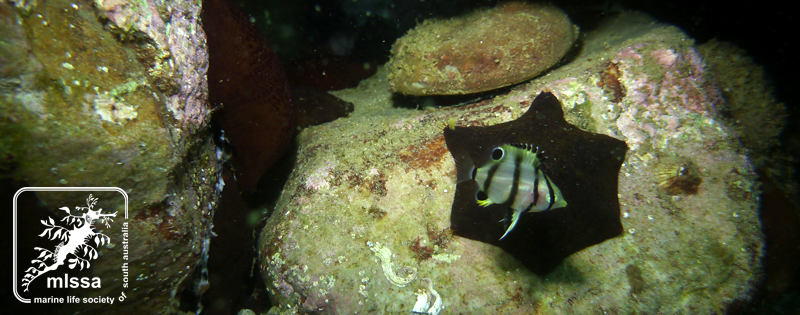Whilst in Port Lincoln last January, I picked up a book from the Visitor Information Centre there. It was “Shores and Shallows of Coffin Bay – An Identification Guide” by Brian Saunders. I had visited Coffin Bay during my trip to Port Lincoln, including the Coffin Bay National Park. The whole area is beautiful. I thought that “Shores and Shallows. . .” was a good book at a good price ($15) but I was certain that it would make a good reference book when working on our own “Beach Wash Guide”. It turned out to be a handy purchase, if only for the following explanation.
I’m not very good when it comes to remembering all manner of scientific names for our marine life, but I was spurred into action when I came across one or two seastar names in “Shores and Shallows”. What appeared to me to be a photo of the cushion star Patiriella brevispina was said to be Meridiastra gunnii and a photo of what appeared to be the little seastar Patiriella exigua was said to be Parvulastra exigua.
A look through Karen Gowlett-Holmes’ book “A Field Guide to the Marine Invertebrates of South Australia” revealed that the Family Asterinidae (cushion seastars) had “undergone major taxonomic revision in recent years, and most names have been changed.” Karen (one of my old dive buddies) suggested that some of the papers listed in the references should be consulted for further details. The genus name Patiriella has now been replaced by that of Meridiastra. This means that species such as P. calcar are now being called M. calcar. Asterina atyphoida has now become M. atyphoida. P.exigua has, however, now become Parvulastra exigua. There has been a major ‘shakeup’ re P. brevispina and P. gunnii. P. brevispina is now called M. gunnii and P.gunnii has now become M. medius, M. occidens and M. oriens, all new species described by O’Loughlin, Waters & Roy in 2003.
I also discovered from Karen’s book that Nepanthia troughtoni is now called Pseudonepanthia troughtoni. By looking at the references in the book “A Field Guide to the Marine Invertebrates of South Australia”, I found a review of the seastar, Patiriella gunnii on the Internet.
An abstract found here reads: – “A molecular and morphological review of the asterinid, Patiriella gunnii (Gray) (Echinodermata: Asteroidea) P. M. O’Loughlin, J. M. Waters and M. S. Roy, 60(2): 181-195 (2003) The six–rayed species of the asterinid genus Patiriella Verrill from the rocky shallows of southern Australia are reviewed. Based on molecular and morphological evidence, it is judged that Patiriella brevispina H.L. Clark is a junior synonym of Patiriella gunnii (Gray). Three new species are described: Patiriella medius sp. nov., Patiriellaoccidens sp. nov. and Patiriella oriens sp. nov. A key to the four species of Patiriella is provided.”
I found the full article here. The linked paper stated that, “P. brevispina is conspecific with P. gunnii, and is thus a junior synonym. The typically six-rayed asterinid seastars which occur in southern Australia are thus the dark crimson P. gunnii and three new variably-coloured species described”. The paper comes from Memoirs of Museum Victoria 60(2): 181–195 (2003), ISSN 1447-2546 (Print) 1447-2554 (On-line), http://www.museum.vic.gov.au/memoirs and http://museumvictoria.com.au/pages/4075/59_2_oloughlina.pdf.
From Memoirs of Museum Victoria I also found “59(2): 277–296 (2002), “New Genus And Species Of Southern Australian And Pacific Asterinidae” by P. MarkO’Loughlin, Honorary Associate, Marine Biology Section, Museum Victoria. The abstract reads: – “The diagnostic characters of the Asterinidae species Asterina atyphoida H.L. Clark from southern Australia and Asterina gibbosa (Pennant) from the Atlantic, type species of Asterina Nardo, are reviewed. Asterina atyphoida is referred to Meridiastra gen. nov., with four other species: Meridiastra fissura sp. nov. and Meridiastranigranota sp. nov. from southern Australia, Meridiastra rapa sp. nov. from the central south Pacific, and Meridiastra modesta (Verrill) from the Pacific coast of Panama and Mexico. Asterina agustincasoi Caso is synonymised with Meridiastra modesta (Verrill). Asterinides Verrill is recognised as a valid genus. Meridiastra fissura is fissiparous. Meridiastra is distributed from southern Australia to the Pacific coast of Mexico and Panama. A key is provided for the species of Meridiastra.”
This is certainly all very involved. My first thoughts were that many of my books and records needed updating to reflect these latest changes. I have now done my best to update names in books such as “Between Tasmanian Tide lines” and “Sea Stars of Australasia and their relatives” (by Neville Coleman).
I also did the same in our “MLSSA Starfish Identification Guide” (mlssa No.5027), a guide that I put together years ago. The guide included the “Key to some common sea stars” from one of our early Journals. The names for almost half of the sea stars in the key have been changed over the years. My next thought was that I would now need to update the names of seastars in our Photo Index records. As it turned out, I only had to make one change. This, however, highlighted the fact that our Photo Index is lacking many species, especially the old Patiriella species. So what we need is many more seastar photos coming in.

